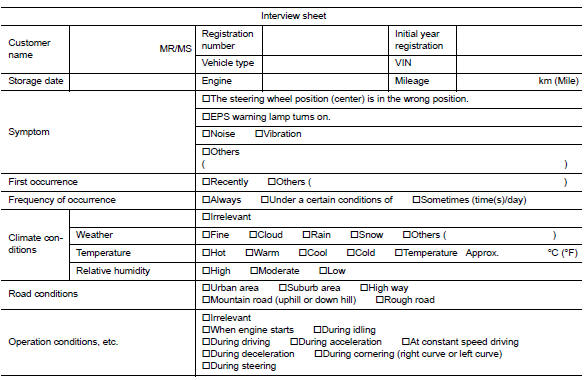Nissan Sentra Service Manual: Basic inspection
Diagnosis and repair workflow
Work Flow
Detailed flow
1.Interview from the customer
Clarify customer complaints before inspection. First of all, perform an interview utilizing stc-20, "diagnostic work sheet" and reproduce symptoms as well as fully understand it. Ask customer about his/her complaints carefully. Check symptoms by driving vehicle with customer, if necessary.
Caution:
Customers are not professional. Never guess easily like “maybe the customer means that...,” Or “maybe the customer mentions this symptom”.
>> Go to 2.
2.Check symptom
Reproduce the symptom that is indicated by the customer, based on the information from the customer obtained by interview. Also check that the symptom is not caused by protection function. Refer to STC-13, "Protection Function".
Caution:
When the symptom is caused by normal operation, fully inspect each portion and obtain the understanding of customer that the symptom is not caused by a malfunction.
>> Go to 3.
3.Perform self-diagnosis
 With consult
With consult
Perform self-diagnosis.
Is any dtc detected? Yes >> record or print dtc and freeze frame data (ffd). Go to 4.
No >> go to 6.
4.Recheck symptom
 With consult
With consult
-
Erase self-diagnostic results.
-
Perform dtc confirmation procedures for the malfunctioning system.
Note:
If some DTCs are detected at the same time, determine the order for performing the diagnosis based on STC- 14, "DTC Inspection Priority Chart".
Is any dtc detected? Yes >> go to 5.
No >> check harness and connectors based on the information obtained by interview. Refer to gi-39, "intermittent incident".
5.Repair or replace malfunctioning parts
-
Repair or replace malfunctioning parts
-
Reconnect part or connector after repairing or replacing.
-
When dtc is detected, erase self-diagnostic results for “eps”.
>> Go to 7.
6.Identify malfunctioning system by symptom diagnosis
Estimate malfunctioning system based on symptom diagnosis and perform inspection.
Can the malfunctioning system be identified?
Yes >> go to 7.
No >> check harness and connectors based on the information obtained by interview. Refer to gi-39, "intermittent incident".
7.Final check
 With consult
With consult
-
Check the reference value for eps control unit.
-
Recheck the symptom and check that symptom is not reproduced on the same conditions.
Is the symptom reproduced? YES >> GO TO 3.
NO >> Inspection End.
Diagnostic Work Sheet
Description
-
In general, customers have their own criteria for a problem. Therefore, it is important to understand the symptom and status well enough by asking the customer about his/her concerns carefully. To systemize all the information for the diagnosis, prepare the interview sheet referring to the interview points.
-
In some cases, multiple conditions that appear simultaneously may cause a dtc to be detected.
Interview sheet sample


 Wiring diagram
Wiring diagram
Power steering control system
Wiring Diagram
...
Other materials:
Uniform tire quality grading
DOT (Department of Transportation) Quality
Grades: All passenger car tires must conform to
federal safety requirements in addition to these
grades.
Quality grades can be found where applicable on
the tire sidewall between tread shoulder and
maximum section width. For example:
Treadwear 200 ...
Basic inspection
Diagnosis and repair workflow
Work flow
OVERALL SEQUENCE
DETAILED FLOW
1.GET INFORMATION FOR SYMPTOM
Get detailed information from the customer about the symptom (the condition
and the environment when the
incident/malfunction occurred).
>> GO TO 2
2.CONFIRM THE SYMPTOM
Try to ...
P0137 HO2S2
DTC Logic
DTC DETECTION LOGIC
The heated oxygen sensor 2 has a much longer switching time
between rich and lean than the air fuel ratio (A/F) sensor 1. The oxygen
storage capacity of the three way catalyst (manifold) causes the
longer switching time. To judge the malfunctions of heated oxygen
...

